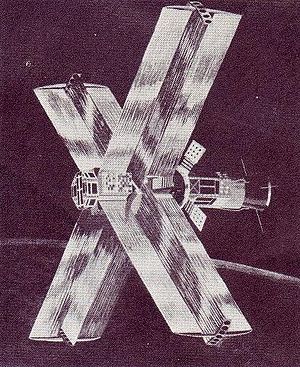Meteoroid Technology Satellite
- Meteoroid Technology Satellite
-
| Meteoroid Technology Satellite |

MTS / Explorer 46 |
| Organización |
NASA |
| Estado |
Reentrado en la atmósfera |
| Fecha de lanzamiento |
13 de agosto de 1972 |
| Vehículo de lanzamiento |
Scout |
| Sitio de lanzamiento |
Wallops Island |
| Reingreso |
2 de noviembre de 1979 |
| Aplicación |
Científico |
| Masa |
136 kg |
| Dimensiones |
3,2 m de largo por 7 m de ancho |
| NSSDC ID |
1972-061A |
Meteoroid Technology Satellite o MTS, también conocido como Explorer 46, fue un satélite artificial de la NASA lanzado el 13 de agosto de 1972 mediante un cohete Scout desde la base de Wallops Island.
La misión de MTS era la de medir las tasas de penetración de meteoroides en un objetivo expuesto y obtener datos sobre la velocidad y distribución del flujo de meteoroides. El cuerpo central del satélite medía 320 cm de largo y portaba los experimentos de impacto, estando los objetivos dispuestos alrededor del satélite y haciendo que su anchura fuese de 701,5 cm.
Referencias
- Wade, Mark (2008). «MTS» (en inglés). Consultado el 15 de abril de 2009.
Categorías: - Satélites artificiales de Estados Unidos
- Satélites experimentales
- Satélites artificiales lanzados en 1972
Wikimedia foundation.
2010.
Mira otros diccionarios:
List of Mobile Suit Gundam 00 technology — This is a list of fictitious technological terminology from the anime series Mobile Suit Gundam 00 .Orbital Elevator SystemNecessitated under high level energy consumption as a renewable alternative to the dwindling fossil fuel supplies, the… … Wikipedia
Near Earth Object Surveillance Satellite — The Near Earth Object Surveillance Satellite (NEOSSat)[1] is a Canadian microsatellite using a 15 cm aperture f/5.88 Maksutov telescope similar to that on the MOST spacecraft, 3 axis stabilized with pointing stability of 2 arcseconds in a 100… … Wikipedia
A-105 — was the third flight of an operational Saturn I and was the last in the series of Saturn I flights.OverviewThe payload consisted of an Apollo boilerplate spacecraft (BP 9A) which served as a shroud for the third Pegasus meteoroid technology… … Wikipedia
Эксплорер (программа) — У этого термина существуют и другие значения, см. Эксплорер … Википедия
A-104 — was the ninth test flight of the Saturn I. This mission was the second flight in the Saturn I operational series and the fourth vehicle to carry an Apollo boilerplate spacecraft. The vehicle also launched the Pegasus B meteoroid technology… … Wikipedia
Liste der Explorer-Missionen — Die Liste der Explorer Missionen führt chronologisch geordnet alle Satelliten auf, die im Explorer Programm der NASA realisiert wurden. Dabei werden auch die Satelliten genannt, die aufgrund des Versagens der Trägerrakete keine Umlaufbahn… … Deutsch Wikipedia
MTS — 1. Magnetic Torquing System Contributor: GSFC 2. Manpower Tracking System Contributor: GSFC 3. Meteoroid Technology Satellite Contributor: GSFC 4. Middle Thermal Shield Contributor: GSFC … NASA Acronyms
A-103 — was the eighth unmanned Saturn flight of the Apollo program. It was the initial vehicle in the operational series of Saturn I launch vehicles and the third to carry an Apollo boilerplate payload. The vehicle also orbited the first of three… … Wikipedia
Space debris — populations seen from outside geosynchronous orbit (GEO). Note the two primary debris fields, the ring of objects in GEO, and the cloud of objects in low earth orbit (LEO) … Wikipedia
Vela Incident — Orthographic projection centered on the Prince Edward Islands, the location of the Vela incident The Vela Incident (sometimes referred to as the South Atlantic Flash) was an unidentified double flash of light that was detected by an American Vela … Wikipedia

